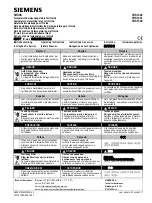
GE Power Management
LPS-D Line Protection System
2-
39
2 CALCULATION OF SETTINGS
2.3 PROTECTION SETTINGS
2
•
Blocking, Hybrid and POTT2 Schemes
Timer TL25 is used to establish transient blocking for the phase and ground distance functions (Z4PHASE
and Z4GROUND). Transient blocking is used to prevent tripping during:
1.
Current reversals that can occur as a result of sequential clearing of faults on a parallel line,
2.
voltage reversals that can occur for faults near capacitors on series compensated lines, and
3.
transients that can occur for external fault clearing.
The following settings are proposed:
Single phase tripping schemes:
TL25DRPOUT = 30 ms
Three phase tripping schemes:
TL25DRPOUT = 50 ms
1311: TL26PICKUP - Repeat Delay Timer
•
Step Distance, Blocking, POTT1 and POTT2 Schemes
Timer TL26 is not used in these schemes, therefore it will be ignored. Any setting made is irrelevant.
•
Hybrid Scheme
Timer TL26 is used to delay repeat of the channel trip signal that is received from the remote terminal of
the line. It is included to provide coordination with a scheme other than an LPS-D that may be used at the
remote terminal of the line.
The following settings are proposed:
With an LPS-D relay at the remote terminal of the line:
TL26PICKUP = 0 ms
With other than an LPS-D relay at the remote terminal of the line:
TL26PICKUP =
where
is the maximum difference in operating time between the blocking functions in
the LPS-D relay and the tripping functions in the system at the remote end of the line. If
, ignore this term in the calculation.
C
is the channel time of the communications channel.
P
is the channel propagation time from the remote terminal to the local terminal.
2.3.15 LINE INFO
1401: POSSEQANG - Positive Sequence Impedance Angle
POSSEQANG is common to all of the distance functions and establishes the positive sequence angle of max-
imum reach. Set POSSEQANG to a value that is equal to or just larger than the angle of the positive-sequence
impedance of the protected line.
1402: ZERSEQANG - Zero Sequence Impedance Angle
ZERSEQANG is common to all of the ground-distance functions and establishes the zero sequence angle of
maximum reach. Set ZERSEQANG to a value that is equal to, or just larger than, the angle of the
zero-sequence impedance of the protected line.
Z
Blocal
Z
Tremote
–
P
C
+
+
Z
Blocal
Z
Tremote
–
Z
Blocal
Z
Tremote
<
Содержание LPS-D
Страница 2: ......
Страница 4: ......
Страница 164: ...3 14 LPS D Line Protection System GE Power Management 3 3 PRINTED CIRCUIT BOARD MODULES 3 HARDWARE DESCRIPTION 3 ...
Страница 226: ...7 4 LPS D Line Protection System GE Power Management 7 1 RATINGS 7 SPECIFICATIONS 7 ...
Страница 284: ...10 20 LPS D Line Protection System GE Power Management 10 8 HELP MENU 10 ALPS TEST PROGRAM 10 ...
Страница 334: ...A 4 LPS D Line Protection System GE Power Management A 1 FREQUENTLY ASKED QUESTIONS APPENDIXA A ...
Страница 412: ...C 34 LPS D Line Protection System GE Power Management C 3 POINT LISTS APPENDIXC C ...
Страница 416: ...D 4 LPS D Line Protection System GE Power Management D 1 KEYPAD MENUS APPENDIXD D ...
Страница 422: ...F 2 LPS D Line Protection System GE Power Management F 1 WARRANTY INFORMATION APPENDIXF F ...
Страница 435: ...GE Power Management LPS D Line Protection System xiii INDEX INDEX tests 6 11 ZONE TIMER functional tests 5 10 ...
Страница 436: ...xiv LPS D Line Protection System GE Power Management INDEX INDEX ...
















































